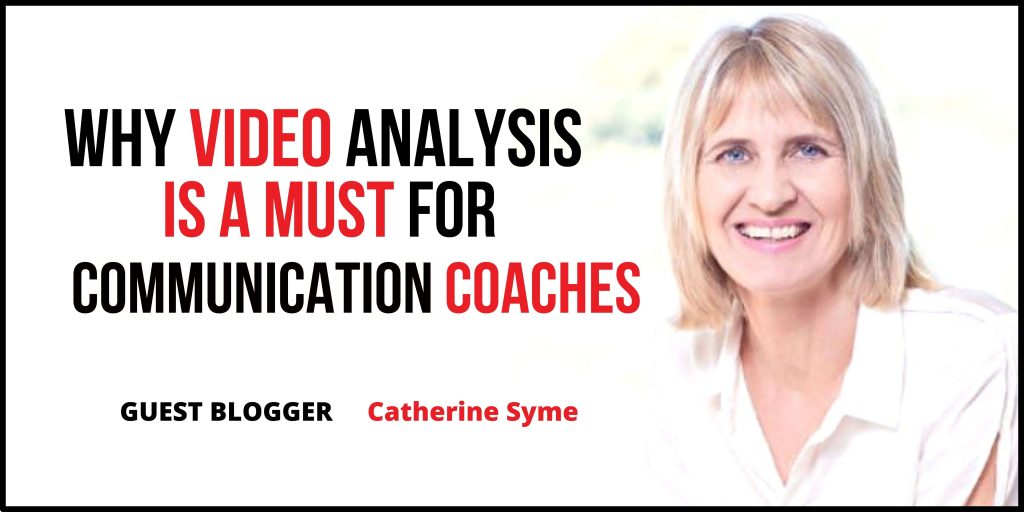Guest blogger: Catherine Syme

Two recent pieces of client feedback reminded me of the value of video as a coaching tool for communication courses.
First, I had a client tell me that she cried for fifteen minutes after watching a video of herself presenting at a public speaking course I ran. Then she explained they were tears of relief….and tears of regret. She realized, after watching herself, that she had been unreasonably hard on herself for so many years.
A few days later, I received this message from Anthony, an ex-client.
“Hey Catherine, just wanted to let you know your speech classes have helped me so much in securing the role I have now. The most powerful part for me was watching myself in the videos – although inside, my nerves were frantic, they didn’t show on the outside. My interview process was four weeks with multiple zoom interviews and talks. Thank you!”
To give you a bit of context, Anthony felt so nervous doing a speech in my course that his heart rate monitor started beeping as his heart rate exceeded 170 beats per minute!
I only videoed on request when I first started coaching because I thought it might be too off-putting for people. But then I noticed something. The few people who asked to be videoed invariably told me how helpful it was.
I have changed my approach now. I tell participants that I will video them unless they ask me not to. They usually look a bit horrified, but guess what? No one has ever objected!
Video is powerful because it helps you see yourself as others do
Video is very handy to reassure nervous public speakers like my clients. Speakers who experience anxiety usually worry that their nerves are obvious. But in my four years as a public speaking coach, specializing in helping highly anxious people, I have observed that this is seldom true. I can tell they are a bit nervous because they speak fast or are overly reliant on notes – but the pounding heart and nausea are not visible! Even shaking is usually not noticeable.
Even when I (and others in the group) tell people that they don’t look nervous, they don’t really believe it until they see it for themselves.
Another client stopped several times during one of his presentations, saying, “My legs are shaking, my legs are shaking.” I told him to keep going as we couldn’t see his legs shaking. The next day I sent him his video, and he came right back at me with an email saying, “omg, I can’t believe you were right!“
I even have my own video story. I took a public speaking course many years ago, and the coach videoed our last presentation. I made a mistake about halfway through and felt like I had messed up the presentation. I was so embarrassed that it took me three months to watch the video. I sat there nervously waiting for the blunder – and then almost missed it because it was so minor! It looked like a brief pause and a quick recovery – nothing that most people would notice, let alone remember!!
Knowing their nerves are not evident is a massive relief for most people! It can
give them a real boost of confidence.
What about the cringe factor?
Yes, the cringe factor is real. The initial relief from realizing they don’t look nervous can be quickly replaced by people’s negative reactions when they see themselves on video. Even hearing their voice will trigger the cringe factor for most people.
And the cringe factor is a bit complicated. On the one hand, we tend to fixate on things the audience doesn’t pay much attention to. For example, when I watch myself on video, I notice that I blink a lot. I can’t do anything about it, and I think it unlikely that others will notice it – but I don’t like it!
Our tendency to be highly self-critical needs to be held in check. I recommend that people watch their videos twice – the first time with the sound off to avoid “voice confrontation syndrome” (yes, it has a name!).
But sometimes, the cringe factor comes from recognising something both noticeable and fixable. For example, you might pick up a nervous habit like a tendency to rock or fiddle with a pen. Or perhaps you flit your eyes around the room without making eye contact.
This leads me to the next point.
Video is also great for helping you improve
Rather than judging themselves, I encourage people to ‘get curious’!
I remember my husband taking a lesson to improve his golf swing. He received a video of himself that he watched many times. He was fascinated by his own golf swing, and the video helped him understand how he needed to change it.
I ask people to approach public speaking in the same interested and non-judgemental way. I encourage them to watch themself on video, figure out what works and what doesn’t and experiment with making changes.
The rise of online meetings and events has made video footage more readily available to most of us. This is gold.
I still find it tempting to fast forward through my own footage, but I have been forcing myself to watch it, and I have picked up something important. I don’t have a natural ability to smile as I speak, so I have to make a deliberate effort to smile when I pause. I thought I was doing so but watching myself, I realize my smile still looks half-hearted. I come across quite well but a bit serious! Being conscious of smiling feels like I am overdoing it at times – but the video footage tells a different story!
I suggest that my clients use video to practice their presentations. They can fast-track their progress by picking some things they want to change. By the time they present in class, they have already addressed some obvious areas for improvement.
I have recently started using Yoodli – an AI public speaking tool. I upload presentations into Yoodli before I send them to my clients. The software provides them with metrics about their speaking, such as their talking speed and use of ‘filler words’. It has some cool features, such as the ability to replay the video at 75% speed so that people can hear the benefit of slowing down. It also allows a coach to provide time-stamped feedback.
I believe that providing these analytics helps reduce the cringe factor because it encourages people to focus on the data. Many people find this interesting, and it promotes curiosity over self-criticism!
If you are reading this as a communications coach, I hope this article has inspired you to use video to build your clients’ confidence and improve their skills. And if you are aspiring to be a better speaker, I encourage you to move past the cringe factor and use video as a teacher.
Catherine Syme is a public speaking coach and owner of Fear-less Public Speaking. Fear-less specializes in helping people with public speaking anxiety. Catherine’s purpose is to help people advance their career or grow their business, by addressing their fear of public speaking. She has a firm belief that anyone can learn to become a confident communicator with the right support.
You can find other articles by Catherine on her Fear-less website, or here on Medium.
You can visit Catherine’s Yoodli coaching website if you would like to find out more about her coaching.
Fear-less Public Speaking: www.fear-less.co.nz
Dan Ram ignites the stage as an in-person event and virtual event MC/ Moderator & Speaker at over 100 events a year. He has shared the stage with international luminaries including President Barack Obama, Sir Richard Branson, Reid Hoffman, Nico Rosberg, and Grammy-winning artists and celebrities. He has also been recognized as a Top 40 under 40 leader 2020 as well as a Top 100 Yale Alumni in Technology 2021. Level up your communication skills through his course and mastermind “Speaking Success”. His passion is to inspire people with his motto ‘Start Now Start Simple’ in building a future we all want to live in.


It can be hard to believe sometimes that we can come to the exact same conclusions as the people that coach us if we just watch ourselves on video…but its so true! Thanks for this blog Catherine. Now, if I could only get over the CRINGE Factor!!!!